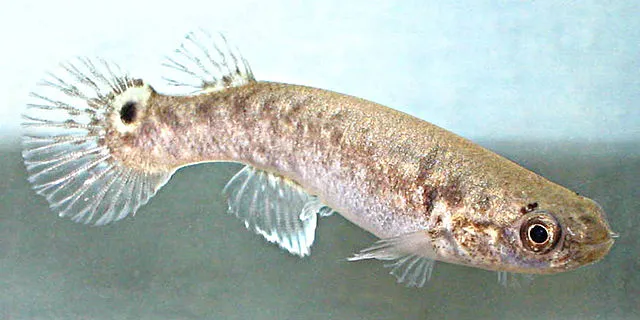There are plenty of contenders for the coveted title of weirdest fish in the world. Fish come in a whole array of different shapes, colours and sizes, many with unique adaptations.
- Prettiest sea animals. Meet some of the most beautiful - and sparkliest - creatures in the ocean
- Like to dive? Check out these extraordinarily beautiful underwater statues teeming with wildlife
Some can change colour, one has a see-through head and some can even fly.... There's even a fish that looks like it's made out of pipe cleaners
Meet some of the strangest and weirdest fish in the world...
Weirdest fish
Pacific barreleye fish
It doesn't come much weirder than having a see-through head! The skull of the Pacific barreleye fish (Macropinna microstoma) is transparent, as is the skin on its head and most of its face.
These features enable it to see things more clearly. It’s the only animal known to have eyes below the skin inside its head. This odd design protects these vital organs, on which the fish’s life depends.
The barreleye lives at depths of up to 1km throughout the northern Pacific Ocean, where little light reaches.
There, this pint-sized weird fish – which is just a few centimetres long – specialises in stealing prey from jellyfish, tracking the ghostly predators by their shadows or faint bioluminescence.
The special tube-shaped eyes, after which it is named, make this stealthy stalking possible. Like tiny binoculars, they provide tunnel vision with a sharp focus on minute details. The fish’s green lenses also highlight any firefly-like glows in the dark.
We named the Pacific barreleye fish one of the strangest animals in the world
Mangrove rivulus

As fish go the mangrove rivulus is pretty strange. They usually lives in brackish pools but, when conditions dry up, the fish has an amazing survival response: it hides inside logs. As their pools diminish, these intrepid fish wriggle into moist cavities in rotten wood. Packed in like sardines, they can live here for up to 66 days without even changing their metabolism.
Stargazer fish
Sporting almost comically goggly, upward-looking eyes (from which it gets its name), the stargazer spends most of its time buried in sediment on the seabed, waiting to launch itself at passing prey. Its own predators are deterred by means of a defensive armoury that includes venomous spines and electric shocks. Stuart Blackman
Flowerhorn cichlid

If every face tells a story, this one might have a sorry tale to relate about the time a golf ball landed in its pond. But there’s been no tragic sporting accident here. The enormous swollen forehead of this flowerhorn cichlid is called the nuchal hump, a feature that seems to be involved in mate-attraction.
Cichlid fish are famous for their ability to form new species rapidly, which draws the attention of evolutionary biologists and fish breeders alike. Indeed, the flowerhorn is a selectively bred product of the aquarium trade, but has been released in several locations around the world and often has invasive tendencies. Stuart Blackman
Cuttlefish
Cuttlefish have some of the most impressive courtship routines in nature. Big males adopt a striking zebra-stripe pattern on one side of their body to ward off rivals, while simultaneously displaying an attractive mottled pattern to a female on the other – quite a feat.
But what if you’re not a large male able to scare off competitors? Some little ’uns ingeniously turn a dappled colour, round out their body shape and act very demure, exactly like a female.
These ‘sneaker’ males slowly sidle up to an existing mating pair, and the dominant male is only too happy to accept another female to his side. Once in under the radar, the imposter mates with the female, then rapidly jets away before his cover is blown. This approach is so successful it has become an entire alternative mating strategy amongst cuttlefish: brains over brawn! Alix Harvey
Blobfish
No list of weird fish would be complete without a mention of the notorious blobfish.
It can be found at 1,200m deep and it is this deep-water living that causes it to look like an “85-year-old Mr Blobby” (according to the fish manager at the Australian Museum, which holds the most well-known and photographed specimen). The blobfish is actually a very misunderstood and unfairly judged creature.
Queen parrotfish
The queen parrotfish Scarus vetula is by day a beautiful and diver-friendly reef fish. By night, it’s a reclusive slime-bag. Literally.
Come sundown, this fish slips into a crevice and, using special glands behind its gills, secretes a bubble of mucus that swells up and over its head like a diving helmet. The pouch spreads towards the fish’s tail and, within 30 minutes or so, the fish is resting inside a surprisingly spacious sac of slime.
An adaption that makes worthy of a place on the list of weirdest fish.
Yellow longnose butterfly fish
As clearly celebrated in its name, the yellow longnose butterfly fish has a nose that is - well - weirdly long. But this extended appendage is extremely useful, enabling the fish to access tiny food items lurking in nooks and crannies in the coral, giving it an advantage over its peers.
The species also feeds by using its powerful teeth to rip into bristleworms and sea urchins. Viewed from the front, its snout resembles a pair of forceps, leading to its alternate name of forceps fish.
Flying fish
Fish that can fly? Yes really! OK - technically they glide rather than fly - but it's still pretty impressive and a bit weird. Flying fish have ‘wings’, composed of either one or two pairs of wide, elongated fins that they unfurl to perform their aeronautical acrobatics. They don’t flap their wings, but build up speed underwater with beats of their tail, then launch through the waterline and glide, wings steady, like paper aeroplanes.
Hairy frogfish
Animal, vegetable or mineral? Even once you’ve worked that one out, the fur and walking legs might throw you. Hairy frogfish, like other anglerfish, tempt prey by waggling a wormlike lure at the end of a modified spine of the dorsal fin.
Curious victims are sucked up by the current created when the predator opens its enormous mouth, which can accommodate prey larger than the frogfish itself.
More unusually, the four pectoral and pelvic fins are modified for crawling over the seafloor. This weird fish species occurs in yellow, red, black, white, spotted and striped forms, according to habitat. The hairstyle is variable, too – spikier types are thought to mimic sea urchins. Stuart Blackman
Red-lipped batfish

The red-lipped batfish Ogcocephalus darwini looks like it has just slapped on a coat of lipstick in the toilets after a few too many drinks. And judging by the downturned expression, the night isn’t going terribly well. This bizarre anglerfish is endemic to the Galápagos Islands. It is a rather poor swimmer, but makes up for it with modified fins that allow it to crawl along the seabed. It’s possible that the lips are used in courtship.
Ornate ghost pipefish
You could hardly accuse this colourful pipefish of being boring, but compared to its closest cousins, it is a tad conventional. Seahorses, seadragons and true pipefish are famous for tearing up the traditional gender-role rulebook, with males giving birth to young. But ghost pipefish do things the old fashioned way. It’s still not entirely straightforward though – females must carry their eggs in a pouch formed from pelvic fins, supplying them with nutrients through their skin until they hatch. Stuart Blackman
Sawfish

It doesn't take a genius to guess how this peculiar fish got its name! Sawfish are rays, not sharks, and are named after the long rostrum or ‘saw’ on the front of the head, which is lined with a series of rostral teeth. It's quite easy to imagine them doing a spot of DIY.
They're not small either, with one species of sawfish able to grow up to 7 metres in length, which is larger than a great white shark.
Archerfish
Woe betide any insect perching on a leafy frond near the water’s edge if the aptly-named archerfish lurks nearby.
This predator can strike its prey with a mouthful of water from up to three metres away, even compensating for the way light bends as it crosses the waterline and adjusting its aim to make a direct hit.
Oarfish
The giant oarfish (Regalecus glesne) is the longest known bony fish on the planet. A record-breaking 7.6 metre specimen was caught in Maine, USA, tipping the scales at 272kg (that’s longer than a saltwater crocodile and heavier than a Shetland pony) but some believe they can grow even longer.
Despite their staggering size, these deep-sea fish are rarely seen because they live in the ocean’s mesopelagic zone.
Some legends warn that when they wash up on shore, an earthquake or other natural disaster may be on the way. This has led to them being ominously referred to as “harbingers of doom”.

The grumpy dwarfgoby is burning red. Although it looks red in the face with anger, its colouration is actually clever camouflage. Grumpy dwarfgobies are usually found hiding in tiny crevices on coral walls and overhangs covered in red coralline algae, so matching their colour helps it to blend in. It uses its large canines to capture tiny invertebrates to eat.






